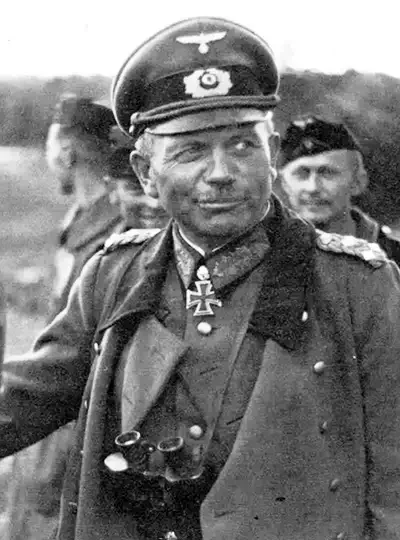- Military History
- Biographies
- Militarians Biographies
- Generaloberst Heinz Guderian
Generaloberst Heinz Guderian
The inventor and vigorous advocate of the "Blitzkrieg" (lightning war) warfare and famous for his successes as a leader of Panzer (tank) units in Poland, France and in the Soviet Union
Heinz Wilhelm Guderian, a German general during WWII, was the inventor and strong advocate of the "Blitzkrieg" (lightning war) warfare and became famous for his successes as a leader of Panzer (tank) units in Poland, France and in the Soviet Union. Born in KuIm, Germany (present-day Chelmno, Poland) in 1888 to Friedrich Guderian and Clara (née Kirchoff), he entered the German Army in 1907. He was commissioned into a Hanoverian rifle battalion in 1908 and then transferred to become a communications officer.
During World War I, he commanded a radio station, served as a Signals Officer in the 5th Cavalry Division, and was appointed to the General Staff Corps in 1918.
After the war ended, Guderian was chosen to serve in the German Reichswehr and was appointed to the staff of the central command of the Eastern Frontier Guard Service. He joined the Iron Brigade (later known as the Iron Division) as its second General Staff officer and was then assigned as a company commander for the 10th Jäger Battalion (Imperial Guard - light infantry unit). Later he joined the Truppenamt (Troop Office). In 1927, Guderian was promoted to major and transferred to the command of Army transport and motorized tactics in Berlin. This placed Guderian at the center of German development of armored forces.
He became deeply involved in the rebuilding of the German military. Convinced that motorized vehicles would bring significant changes in warfare, he called for changes in tactics. Guderian especially believed that the static trench warfare of World War I would soon be obsolete.
In 1931, Guderian was given command of a motorized battalion. When three German Panzer (tank) divisions were created in 1935, Guderian was named to command one. He pioneered motorized tactics in the pre-WW II army and kept himself informed about international tank development. He promoted the use of radio communication between tank crews and devised shock-tactics that proved highly effective. During this time, he wrote his first book, Achtung - Panzer! (Beware the Tank!), which was published in 1937. In 1938, Guderian became chief of all mobile German troops.
At the beginning of World War II, most European planners expected a long, drawn-out war. Instead, the lightning speed of the German armored units stunned the Poles, and Germany conquered Poland in only six weeks. During the invasion of Poland, Guderian led the XIX Corps. This corps comprised a panzer division and two motorized infantry divisions which he successfully led in the Battle of Wizna and the Battle of Kobryn.
The successes in Poland proved Guderian's military philosophy, and he was given the task of planning the invasion of France. It also confirmed his key motto: "Klotzen, nicht kleckern (Slog, don't fiddle about). Guderian himself led the Panzers into France in the spring of 1940, which broke the French defenses at Sedan, resulting in the surrender of France.
The stunning German successes there were even greater than he had hoped for, and his nervous superiors back in Berlin became anxious that he might exceed his directives. Hitler himself called a halt to the offensive a short distance from Dunkirk, where the Germans might have destroyed the British army before it was evacuated from the continent. By this time, Guderian was called "father of the Panzer divisions”.
In 1941, Guderian commanded the Second Panzerarmee (tank army) in its thrust into Russia; he gained immense victories by isolating and enveloping Russian forces. Guderian, however, had reached his high-water mark; orders from Hitler delayed his attack on Moscow with whom he disagreed sharply. The Soviets then launched a counterattack that sent the German forces reeling and threatened a general collapse. Guderian could not pull his forces back, but was ordered to "stand fast", keeping them all in their current positions. Disobeying his orders, he withdrew. After several heated disputes with Generalfeldmarschall Günther von Kluge, the commander of the Army Group Centre, Guderian was relieved at the end of 1941 and transferred to the reserve.
Guderian passed an uneventful two and a half years, publishing his book "Mit den Panzern in Ost and West" (With tanks in east and west). After the defeat at Stalingrad, he was appointed to rebuild the shattered German Panzer forces and later summoned to serve as Chief of the Army General Staff (July 1944 - March 1945).
Guderian and his staff surrendered to US forces on May 10, 1945. He remained as a prisoner of war in US custody until his release in June 1948. Although Guderian was complicit in the arrest and shooting of many Soviet Red Army prisoners, he was never brought to trial. He wrote two more books: "Kann Westeuropa verteidigt werden?" (Can western Europe be defended’) and "Panzer Leader".
Heinz Guderian died on May 14, 1954 at 65, in Schwangau near Füssen, Southern Bavaria, and is buried at the Friedhof Hildesheimer Straße in Goslar, Germany.
Generaloberst Heinz Guderian - Quick Facts
- German Empire (1866-1918)
- Germany - Weimar Republic (1919-33)
- Germany Nazi (1933-1945)
- 2nd Panzer Army (German Wehrmacht 1940-1945)
- 2nd Panzer Division (German Wehrmacht 1935-1945)
- XIX Army Corps (German Wehrmacht 1939-1945)
- XVI Army Corps (German Wehrmacht 1938-1945)
- WWI (1914-1918)
- Weimar Republic (1918-1933)
- WWII (1939-1945)
- {{#owner}}
- {{#url}} {{#avatarSrc}}
{{name}} {{/url}} {{^url}} {{#avatar}} {{& avatar}} {{/avatar}} {{name}} {{/url}} - {{/owner}} {{#created}}
- {{created}} {{/created}}
























